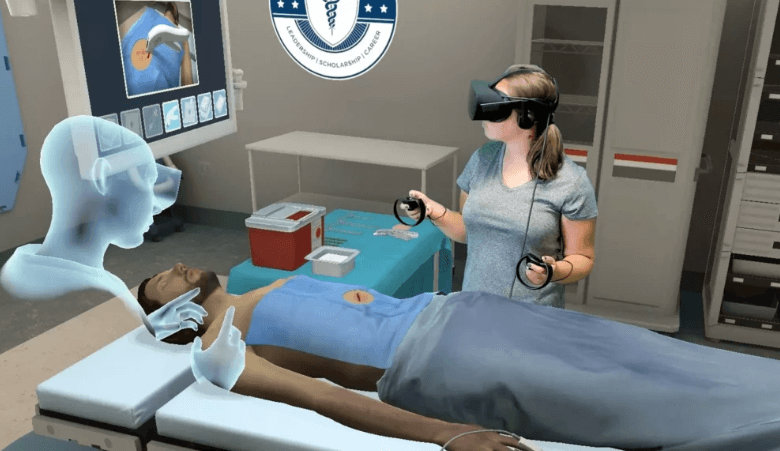The Role of Virtual Reality in Education and Training

In recent years, technology has rapidly changed many sectors, including education and training. One of the most exciting innovations is Virtual Reality (VR), a tool that has redefined how individuals learn and develop new skills. Virtual Reality in education and training has moved beyond the realm of gaming and entertainment into more practical applications that have the potential to revolutionize the way knowledge is transferred.
In this article, we explore how Virtual Reality is influencing the world of education and training, its benefits, challenges, and what the future may hold for immersive learning experiences.
What is Virtual Reality (VR)?
Definition and Basics
Virtual Reality refers to a simulated experience created by a computer system that can replicate real-world environments or generate entirely new ones. Through VR headsets, users can engage with these environments in an immersive and interactive way. This technology has the potential to change how people experience learning by providing them with experiences that traditional methods cannot offer.
See also: How 5G Will Transform Communication and Connectivity
How VR is Being Used in Education and Training
Immersive Learning Experiences
VR creates an environment where learners can interact with content in ways that engage multiple senses. For example, students studying history can explore ancient civilizations in a VR simulation rather than just reading about them in a textbook. This immersive approach aids in better retention and understanding of the subject matter.
Simulation-Based Training
In fields like medicine, aviation, and engineering, VR is used for practical, hands-on training. Medical students, for instance, can perform virtual surgeries without any risk to real patients, helping them build their skills before working in real-life situations. Similarly, pilots can use VR simulators to practice emergency procedures without the costs and risks of real flight training.
Interactive Classrooms
VR allows for virtual classrooms where students from different parts of the world can attend lectures together. These classrooms can simulate real-world environments or educational settings like labs, museums, or historical sites. With the advancement of VR, these immersive classroom experiences are becoming more interactive, fostering collaboration and engagement.
Benefits of Virtual Reality in Education
Enhanced Engagement and Motivation
The use of VR in education makes learning more engaging. The immersive nature of VR captivates students, keeping their attention longer and making them more motivated to participate in the learning process. Studies have shown that students who use VR for learning tend to score higher in tests and retain knowledge better than those using traditional methods.
Improved Retention
Since VR experiences are often more engaging and interactive, students are able to retain information better. When learners actively participate in simulations and virtual worlds, the brain forms stronger connections with the material. This leads to better memory retention compared to passive learning techniques like reading or listening to lectures.
Cost-Effectiveness in Training
While VR technology may seem expensive upfront, it can reduce long-term costs in training programs. For instance, businesses that use VR for employee training no longer need to rent physical spaces, purchase equipment, or pay for instructors. This can result in significant savings, especially in industries that require specialized training, such as healthcare or aviation.
Safe Learning Environment
One of the most significant advantages of VR is its ability to simulate dangerous or risky scenarios in a controlled environment. Whether it’s medical emergencies or hazardous industrial operations, VR allows learners to practice in situations that would be unsafe in the real world. This safe, risk-free environment ensures learners can make mistakes and learn from them without consequences.
Challenges and Limitations of Virtual Reality in Education
High Initial Costs
While VR has the potential to revolutionize education, it comes with high initial costs, including the purchase of hardware such as VR headsets, software, and system setup. Educational institutions and businesses must weigh these costs against the potential long-term benefits before investing in VR technology.
Lack of Content and Curriculum Development
For VR to reach its full potential in education, there needs to be more VR-compatible educational content. Developing high-quality VR courses, simulations, and training programs requires expertise and time. Educational institutions often lack the resources or personnel to create such content, limiting the widespread use of VR in classrooms.
Technical Issues and Accessibility
Another challenge is the technical complexity of VR systems. Not all schools or organizations are equipped to manage and maintain VR hardware and software. Additionally, accessibility remains an issue for some students, especially those with disabilities or those who cannot afford the technology.
The Future of VR in Education and Training
Integration with Other Technologies
In the coming years, VR will likely integrate more seamlessly with other emerging technologies like Artificial Intelligence (AI), Augmented Reality (AR), and machine learning. For example, AI could help tailor VR learning experiences to individual students, adjusting difficulty levels or providing instant feedback.
Virtual Campus Tours and Distance Learning
As the global demand for remote education increases, VR can provide virtual campus tours, allowing students to explore universities and campuses without leaving their homes. Additionally, distance learning will become more immersive as VR allows students to attend classes in virtual environments, making learning feel more personal and interactive.
Personalized Learning Experiences
The future of education with VR is highly individualized. VR systems could gather data on each student’s progress, preferences, and strengths, creating a personalized learning path. This customization ensures that each student receives the support they need to succeed, regardless of their learning style or pace.
Frequently Asked Questions (FAQs)
1. How can VR improve student engagement?
Virtual Reality makes learning more immersive and hands-on, which can increase student interest and participation. Unlike traditional methods, VR allows students to actively engage with the content, making learning more enjoyable and motivating.
2. Is VR technology expensive?
While the initial investment in VR equipment and software can be high, the long-term cost savings in terms of travel, physical training spaces, and personnel can make it a cost-effective solution for many educational institutions and businesses.
3. Can VR be used for subjects like history or art?
Yes, VR is versatile and can be used for various subjects, including history and art. Students can explore historical events, visit virtual museums, or create their own art in 3D environments, all of which enhance the learning experience.
4. Can VR training replace real-life hands-on training?
While VR training offers many benefits, it cannot fully replace real-life hands-on training, especially in fields that require physical interaction. However, VR is an excellent supplement, providing students with the ability to practice without risk.
5. What are some industries benefiting from VR in training?
VR is being used extensively in industries like healthcare, aviation, manufacturing, and military training. It provides a safe, cost-effective, and immersive way for professionals to practice and enhance their skills.
6. What are the barriers to widespread VR adoption in education?
High costs, lack of content, technical issues, and accessibility problems are some of the primary barriers to VR adoption in education. As technology becomes more affordable and accessible, these challenges will likely decrease.
Conclusion
Virtual Reality has immense potential to transform the way education and training are conducted. It offers an immersive and interactive way to learn, making education more engaging, efficient, and personalized. While there are challenges to widespread adoption, the future of VR in education is promising, with ongoing advancements that will continue to shape how we learn and train in various fields.
As VR technology becomes more affordable and integrated with other emerging tech, its role in education will expand, paving the way for new learning experiences that are interactive, safe, and effective. With its ability to recreate real-world experiences, VR is indeed revolutionizing education and training across the globe.




